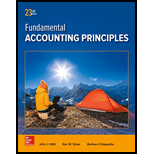
Concept explainers
Journals:
Journals are the books where all the original entries of business transactions are recorded on basis of its occurrence order and date.
Sales Journal:
The journal where all the credit sales of merchandise are recorded is called a Sales Journal.
Cash Receipts Journal:
Cash receipts journal records all type cash receipts of a business organization like cash sales, collections from debtors, loans and borrowings etc.
A subsidiary ledger of accounts receivable shows the amount of money paid and owed by debtors for the transactions made on credit individually.
Schedule of Accounts Receivable:
A schedule of accounts receivable represents the overall amount of money owed by the debtors for credit transactions during a specified period.
To determine:
1. Preparation of sales journal and cash receipts journal. Journalize the transactions that should be recorded in the sales journal and cash receipts journal.
2. Prepare the general ledger accounts and accounts receivable subsidiary ledger accounts.
3. Verify the amounts that should be posted as individual amounts from the journals have been posted. Foot and crossfoot the journals and make the month-end postings.
4. Preparation of
Want to see the full answer?
Check out a sample textbook solution
Chapter 7 Solutions
Fundamental Accounting Principles
- Harlow Corporation is the sole owner and operator of Harlow's Retail. As of the end of its accounting period, December 31, 2022, Harlow's Retail has assets of $2,400,000 and liabilities of $920,000. During 2023, Harlow invested an additional $150,000 and withdrew $80,000 from the business. What is the amount of net income during 2023, assuming that as of December 31, 2023, assets were $2,750,000 and liabilities were $880,000? Need answerarrow_forwardPlease explain the solution to this general accounting problem using the correct accounting principles.arrow_forwardI am looking for a step-by-step explanation of this financial accounting problem with correct standards.arrow_forward

 AccountingAccountingISBN:9781337272094Author:WARREN, Carl S., Reeve, James M., Duchac, Jonathan E.Publisher:Cengage Learning,
AccountingAccountingISBN:9781337272094Author:WARREN, Carl S., Reeve, James M., Duchac, Jonathan E.Publisher:Cengage Learning, Accounting Information SystemsAccountingISBN:9781337619202Author:Hall, James A.Publisher:Cengage Learning,
Accounting Information SystemsAccountingISBN:9781337619202Author:Hall, James A.Publisher:Cengage Learning, Horngren's Cost Accounting: A Managerial Emphasis...AccountingISBN:9780134475585Author:Srikant M. Datar, Madhav V. RajanPublisher:PEARSON
Horngren's Cost Accounting: A Managerial Emphasis...AccountingISBN:9780134475585Author:Srikant M. Datar, Madhav V. RajanPublisher:PEARSON Intermediate AccountingAccountingISBN:9781259722660Author:J. David Spiceland, Mark W. Nelson, Wayne M ThomasPublisher:McGraw-Hill Education
Intermediate AccountingAccountingISBN:9781259722660Author:J. David Spiceland, Mark W. Nelson, Wayne M ThomasPublisher:McGraw-Hill Education Financial and Managerial AccountingAccountingISBN:9781259726705Author:John J Wild, Ken W. Shaw, Barbara Chiappetta Fundamental Accounting PrinciplesPublisher:McGraw-Hill Education
Financial and Managerial AccountingAccountingISBN:9781259726705Author:John J Wild, Ken W. Shaw, Barbara Chiappetta Fundamental Accounting PrinciplesPublisher:McGraw-Hill Education





